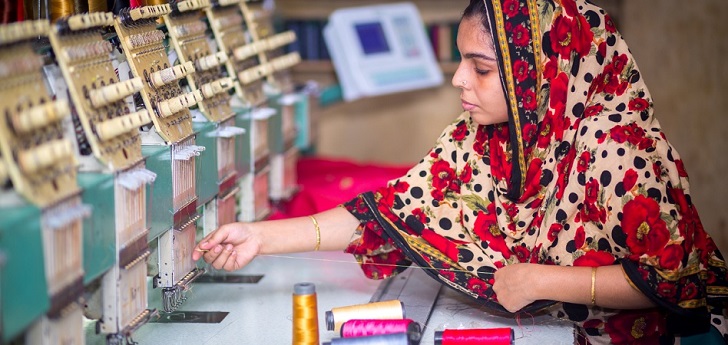Coronavirus: the crisis in China tenses sourcing in Bangladesh on the brink of the monsoon
The transfer to the Asian country of large productions with broken deadlines owing to the crisis in China is causing great chaos in Bangladesh.

“This is like and airport, if the airport has slots for 8 a.m. until 11 pm at night and is obliges a plane to land at 6 a.m. or at two at dawn, it is landing at non-commercial hours.” This is how a senior executive in the sector sums up the paralysis of textile production in China as a result of the coronavirus outbreak and the role of Bangladesh in the current circumstances.
Even more so, the coronavirus crisis is tensing the supply chain in Bangladesh when the country is at the brink of the monsoon season, a time at which occupational accidents tend to surge.
The paralysis of textile production in China since last January has caused large fashion groups, most of them European, to start looking at nearby markets, such as Turkey or Morocco, to stock up. However, large productions are reverting to Bangladesh, a market that accounts for 6% of world textile exports.
In 2018, China accounted for 37.6% of total textile exports and 31.3% of clothing exports, a long distance from the second largest global fashion exporter, the European Union. On the other hand, Bangladesh takes the bronze medal when it comes clothing exports, the Asian country accounts for 6.4% of global trade, according to the latest data from the World Trade Organization (WTO).
The Bengali market has continuously increased its sales abroad during the last decade, and in 2018 it saw a surge of 11%, to 32 billion dollars. It is closely followed by Vietnam, which covers 6.2% of clothing exports; India, with a 3.3% share, and Turkey, with 3.1%, Indonesia, Cambodia and the United States complete the board pie chart representing between 1% and 2%, respectively.
Production is moving to Bangladesh at the most crucial moment of Bengali weather, the pre-monsoon
Industry sources of the sector warn that production is moving to Bangladesh at the most critical moment of the Bengali weather, the pre-monsoon. The monsoon is a seasonal wind that is produced by the displacement of the equatorial belt and travels through Bangladesh from June to September, triggering floods every year that leave fatalities among the country’s population.
The extremely high temperatures of the pre-monsoon season end up affecting the workers, with factories pressured to respond to order with broken delivery times due to the Chinese crisis. Several executives specialized in sourcing admit the risk that this situation may result in work accidents.
“All production has been compromised in a country that has a capacity limit, furthermore, it is already entering in dark side - explains a manager-; that is, they acknowledge production, but you don’t know where they are going to produce it, because the factories are compromised, the slot is sold.”
However, the same sources indicate that since the Rana Plaza catastrophe that took place in 2013 and left more behind more than one thousand dead “the country is very controlled”, while some groups have minimized their activity in the country.
A good example of this is Inditex. Zara’s parent company currently has a small productive activity in Bangladesh: the country concentrates 6% of its suppliers and 4% of factories that work with Inditex in the world. The Spanish group has 114 partners in the country at the end of 2018, which in turn managed 296 factories. With the paralysis of China, Inditex is taking its production to Turkey, a country in proximity that offers faster response capacity.
In parallel, Primark concentrates 90% of its production in Asia. The Irish chain controlled by AB Foods, is also putting Turkey to the test, however, the high volumes and low prices it demands force the company to move its operations from China to other surrounding countries in the market, the main one being Bangladesh.
“The time at which Bangladesh collapses, if it ever comes to collapse, there are no countries left in the world where manufacturing can occur,” advises a director. However, all experts consulted warn that about the risk of shortage. “If I am a company that has a high concentration of my production chain in China, 50% or 40%, the purchasing teams must now be at the point of collapse, because they can't find where to land the plane,” they affirm.
“The time at which Bangladesh collapse, if it ever collapses, there are no countries left in the world where manufacturing can occur,” advises a director. “Let’s not fools ourselves, we are talking about moving billions of units, not millions,” adds another; there is no production capacity in the world that can undertake this.
The fashion industry is one of the pillars of the Bengali economy. Garment alone employs 4.5 million people in the country, covers 84% of its exports and accounts for around 20% of its gross domestic product (GDP).
The Bangladesh Garment Manufacturers and Exporters Association (Bgmea) encompasses around 4,500 factories that, according to the association, represent 100% of flat fabric garments, of which about half are knitted.


info@themds.com
Validation policy for comments:
MDS does not perform prior verification for the publication of comments. However, to prevent anonymous comments from affecting the rights of third parties without the ability to reply, all comments require a valid email address, which won’t be visible or shared.
Enter your name and email address to be able to comment on this news: once you click on the link you will find within your verification email, your comment will be published.